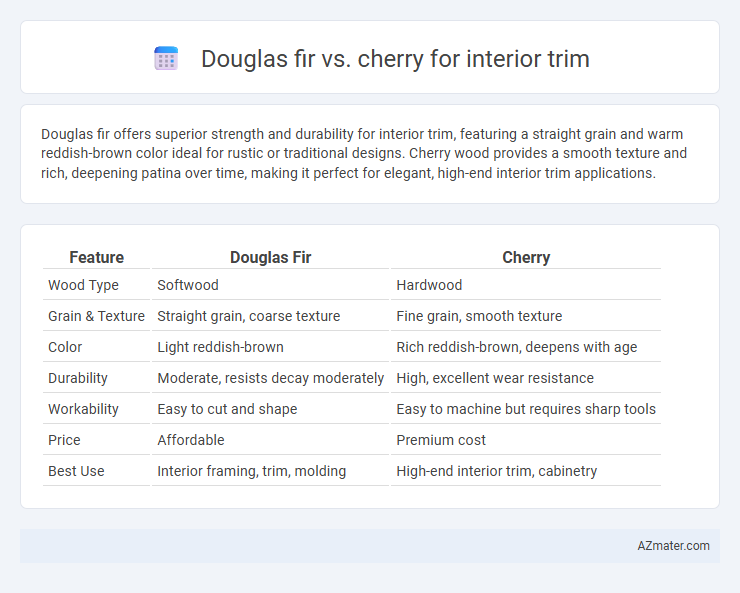Douglas fir offers superior strength and durability for interior trim, featuring a straight grain and warm reddish-brown color ideal for rustic or traditional designs. Cherry wood provides a smooth texture and rich, deepening patina over time, making it perfect for elegant, high-end interior trim applications.
Table of Comparison
| Feature | Douglas Fir | Cherry |
|---|---|---|
| Wood Type | Softwood | Hardwood |
| Grain & Texture | Straight grain, coarse texture | Fine grain, smooth texture |
| Color | Light reddish-brown | Rich reddish-brown, deepens with age |
| Durability | Moderate, resists decay moderately | High, excellent wear resistance |
| Workability | Easy to cut and shape | Easy to machine but requires sharp tools |
| Price | Affordable | Premium cost |
| Best Use | Interior framing, trim, molding | High-end interior trim, cabinetry |
Introduction to Douglas Fir and Cherry for Interior Trim
Douglas fir offers a strong, durable option for interior trim with a straight grain and warm reddish-brown hues that enhance rustic and traditional decor. Cherry wood is prized for its smooth texture, rich reddish-brown color that deepens over time, and fine grain, making it ideal for elegant and sophisticated interior trim. Both woods provide excellent workability and a high-quality finish, but Douglas fir is more affordable and widely available compared to the premium price of cherry.
Appearance and Grain Differences
Douglas fir offers a warm reddish-brown hue with prominent straight grain patterns, providing a rustic and natural look ideal for interior trim. Cherry wood features a rich, reddish tone that deepens to a mahogany shade over time, with a smooth, fine grain giving a more elegant and refined appearance. The distinct grain visibility in Douglas fir contrasts with Cherry's subtle grain, making the choice pivotal based on desired aesthetic impact in trim applications.
Durability and Hardness Comparison
Douglas fir offers moderate durability with a Janka hardness rating of approximately 660, making it relatively soft compared to many hardwoods. Cherry wood, with a Janka hardness around 950, provides greater resistance to dents and wear, enhancing longevity in high-traffic interior trim applications. The superior hardness and durability of cherry make it a preferred choice for trim that requires lasting strength and a refined appearance.
Workability and Ease of Installation
Douglas fir offers excellent workability due to its straight grain and medium hardness, making it easy to cut, nail, and sand for interior trim projects. Cherry wood, while slightly harder, provides smooth sanding and a fine, even texture that allows for precise detailing but may require sharper tools for optimal results. Both woods install relatively easily, though Douglas fir's stability and lighter weight can simplify handling and fitting compared to the denser Cherry.
Cost Considerations and Budgeting
Douglas fir is a cost-effective choice for interior trim, offering durability and a warm, rustic appearance at a lower price point compared to cherry. Cherry wood commands a higher price due to its rich color, fine grain, and luxurious aesthetic, making it a premium option for upscale budgets. Budgeting for cherry trim requires accounting for both material costs and potential staining or finishing expenses, whereas Douglas fir typically entails lower overall installation and maintenance costs.
Finishing Options and Stain Compatibility
Douglas fir offers excellent finishing options with its coarse, open grain that readily accepts stains, particularly enhancing warm tones and natural amber hues. Cherry wood is prized for its smooth grain and rich, reddish-brown color that deepens over time, providing superior compatibility with darker stains and clear finishes that highlight its fine texture. Both woods perform well with polyurethane and lacquer, but Cherry responds better to oil-based stains, while Douglas fir often requires a wood conditioner for even stain absorption.
Maintenance and Longevity
Douglas fir offers high durability and resistance to wear, making it a low-maintenance option for interior trim that can last several decades with proper care. Cherry wood, while prized for its rich color and smooth grain, requires more frequent maintenance such as polishing and refinishing to preserve its appearance over time. Both woods age well, but Douglas fir tends to withstand humidity and scratches better, resulting in longer-lasting trim with less upkeep.
Environmental Impact and Sustainability
Douglas fir offers excellent sustainability with rapid growth rates and efficient carbon sequestration, making it a low-impact choice for interior trim; it is often sourced from responsibly managed forests adhering to certifications like FSC. Cherry wood, while prized for its rich color and durability, has a slower growth rate and is less abundant, which may contribute to a higher environmental footprint and limited availability. Considering environmental impact, Douglas fir's renewable qualities and lower ecosystem disruption make it preferable over cherry for eco-conscious interior trim projects.
Best Applications for Each Wood Type
Douglas fir excels in interior trim applications that require durability and strength, such as baseboards, window casings, and door frames, due to its dense grain and resistance to wear. Cherry is best suited for high-end interior trim projects where aesthetic appeal is paramount, offering a smooth finish and rich reddish-brown color that deepens over time, ideal for decorative moldings and cabinetry trim. Both woods respond well to staining and finishing, but Douglas fir is preferred in areas demanding structural integrity while cherry enhances spaces with its elegant, warm tone.
Which is Better for Your Interior Trim?
Douglas fir offers exceptional durability and a warm, reddish-brown tone that enhances interior trim with natural strength, making it ideal for high-traffic areas. Cherry wood provides a rich, smooth grain and deepens in color over time, delivering a luxurious and elegant finish perfect for formal spaces. Choosing between Douglas fir and Cherry depends on whether durability or aesthetic warmth aligns better with your interior design goals.

Infographic: Douglas fir vs Cherry for Interior Trim
 azmater.com
azmater.com